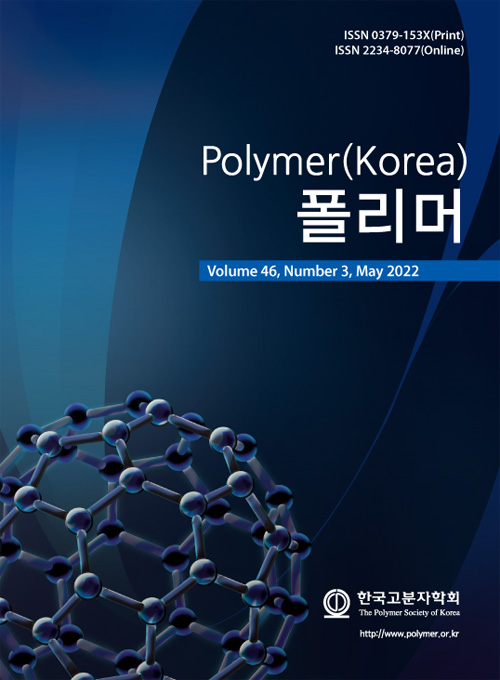- A Novel Self-Healing Polyurethane with High Transparency and Strength: Effects of Multiple Supermolecular Forces
Yuan Liu, Yanmei Liao*, Yintao Long*, Yuxiang Qian**, Shengqiang Nie, Yi Wang, Jia Zeng, Chunmei Zhang, Linbo Tian, and Jun Luo†

Engineering Research Center for Materials Protection of Wear and Corrosion of Guizhou Province,
Guiyang University, Guiyang 550005, China
*State Key Laboratory Breeding Base of Green Pesticide and Agricultural Bioengineering, Key Laboratory of Green Pesticide and Agricultural Bioengineering, Ministry of Education, Center for R&D of Fine Chemicals, Guizhou University, Guiyang 550025, China
**Shanghai Space Propulsion Technology Research Institute, No. 3888, Yuanjiang Road, Minhang District, Shanghai 201100, China- 높은 투명도와 강도를 갖는 자가치료용 Polyurethane: 복합 초분자 상호작용의 영향
Reproduction, stored in a retrieval system, or transmitted in any form of any part of this publication is permitted only by written permission from the Polymer Society of Korea.
It is a considerable challenge for expanding the applications of self-healing polyurethane because of the dilemma in balancing its mechanical and self-healing properties. Herein, a series of self-healing polyurethane systems (PUT-x) with short-range ordered rigid aromatic structures were synthesized by simply adjusting two kinds of diisocyanates, and by ingenious addition of aromatic chain extender. We hope to regulate the π-π interactions and further to manipulate the properties of obtained polyurethanes via adjusting the amount of the benzene rings in the molecular chains of the PUT-x systems. The PUT-5 with decent self-healing ability, optimal mechanical properties, acceptable thermal stability and favorable transparency was selected to incorporate liquid metal and fluorescent powder to fabricate conductive wire and anti-counterfeiting film. Significantly, the liquid metal could be recycled from the conductive wire conveniently without using strong acids or strong bases. Moreover, PUT-5 exemplarily withstood long-term soaking in normal saline, and no deformation could be identified.
Keywords: self-healing, polyurethane, π-π interaction, hydrogen bond, properties.
- Polymer(Korea) 폴리머
- Frequency : Bimonthly(odd)
ISSN 0379-153X(Print)
ISSN 2234-8077(Online)
Abbr. Polym. Korea - 2023 Impact Factor : 0.4
- Indexed in SCIE
 This Article
This Article
-
2022; 46(3): 327-341
Published online May 25, 2022
- 10.7317/pk.2022.46.3.327
- Received on Nov 16, 2021
- Revised on Mar 1, 2022
- Accepted on Mar 12, 2022
 Correspondence to
Correspondence to
- Jun Luo
-
Engineering Research Center for Materials Protection of Wear and Corrosion of Guizhou Province,
Guiyang University, Guiyang 550005, China - E-mail: hx0029@gyu.edu.cn








 Copyright(c) The Polymer Society of Korea. All right reserved.
Copyright(c) The Polymer Society of Korea. All right reserved.